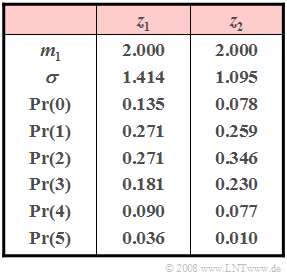Difference between revisions of "Aufgaben:Exercise 2.5: "Binomial" or "Poisson"?"
| Line 4: | Line 4: | ||
[[File:P_ID104__Sto_A_2_5_neu.png|right|frame|Characteristics of $z_1$ and $z_2$]] | [[File:P_ID104__Sto_A_2_5_neu.png|right|frame|Characteristics of $z_1$ and $z_2$]] | ||
| − | Consider two discrete random | + | Consider two discrete random variables $z_1$ and $z_2$ that can take (at least) all integer values between $0$ and $5$ (including these limits). |
| + | |||
| + | The probabilities of these random variables are given in the adjacent table. However, one of the two random variables is not limited to the given range of values. | ||
Furthermore it is known that | Furthermore it is known that | ||
| − | * one of the variables is binomially distributed, and | + | * one of the variables is binomially distributed, and |
* the other describes a Poisson distribution. | * the other describes a Poisson distribution. | ||
| − | However, it is not known which of the two variables$(z_1$ or $z_2)$ is binomially distributed and which is Poisson distributed. | + | However, it is not known which of the two variables $(z_1$ or $z_2)$ is binomially distributed and which is Poisson distributed. |
| − | |||
| − | |||
| Line 24: | Line 24: | ||
Hints: | Hints: | ||
*This exercise belongs to the chapter [[Theory_of_Stochastic_Signals/Poisson_Distribution|Poisson distribution]]. | *This exercise belongs to the chapter [[Theory_of_Stochastic_Signals/Poisson_Distribution|Poisson distribution]]. | ||
| − | *But also refers to the previous chapter [[Theory_of_Stochastic_Signals/Binomial_Distribution| | + | *But also refers to the previous chapter [[Theory_of_Stochastic_Signals/Binomial_Distribution|Binomial Distribution]]. |
| − | *To check your results you can use the interactive applet [[Applets: | + | *To check your results you can use the interactive HTML5/JavaScript applet [[Applets:Binomial_and_Poisson_Distribution_(Applet)|Binomial and Poisson distribution]]. |
| Line 35: | Line 35: | ||
<quiz display=simple> | <quiz display=simple> | ||
| − | {Find out from the probabilities, means, and | + | {Find out from the probabilities, means, and rms values whether $z_1$ or $z_2$ is Poisson distributed. |
| − | |type=" | + | |type="()"} |
+ $z_1$ is Poisson distributed and $z_2$ is binomially distributed. | + $z_1$ is Poisson distributed and $z_2$ is binomially distributed. | ||
- $z_1$ is binomially distributed and $z_2$ is Poisson distributed. | - $z_1$ is binomially distributed and $z_2$ is Poisson distributed. | ||
| Line 52: | Line 52: | ||
| − | {Now consider the binomial distribution. Give its characteristic probability& | + | {Now consider the binomial distribution. Give its characteristic probability&. |
|type="{}"} | |type="{}"} | ||
$p \ = \ $ { 0.4 3% } | $p \ = \ $ { 0.4 3% } | ||
Revision as of 16:02, 18 December 2021
Consider two discrete random variables $z_1$ and $z_2$ that can take (at least) all integer values between $0$ and $5$ (including these limits).
The probabilities of these random variables are given in the adjacent table. However, one of the two random variables is not limited to the given range of values.
Furthermore it is known that
- one of the variables is binomially distributed, and
- the other describes a Poisson distribution.
However, it is not known which of the two variables $(z_1$ or $z_2)$ is binomially distributed and which is Poisson distributed.
Hints:
- This exercise belongs to the chapter Poisson distribution.
- But also refers to the previous chapter Binomial Distribution.
- To check your results you can use the interactive HTML5/JavaScript applet Binomial and Poisson distribution.
Questions
Musterlösung
- Bei der Poissonverteilung sind Mittelwert $m_1$ und Varianz $\sigma^2$ gleich.
- Die Zufallsgröße $z_1$ erfüllt diese Bedingung im Gegensatz zur Zufallsgröße $z_2$.
(2) Bei der Poissonverteilung ist zudem der Mittelwert gleich der Rate. Deshalb muss $\underline{\lambda = 2}$ gelten.
(3) Die entsprechende Wahrscheinlichkeit lautet mit $z_{\rm Poisson} = z_1$:
- $${\rm Pr}(z_1 = 6)=\frac{2^6}{6!}\cdot e^{-2}\hspace{0.15cm} \underline{\approx 0.012}$$
- $${\rm Pr}(z_1 > 6)=1 -{\rm Pr}(0) -{\rm Pr}(1) - \ \text{...} \ - {\rm Pr}(6)\hspace{0.15cm} \underline{\approx 0.004}.$$
(4) Für die Varianz der Binomialverteilung gilt:
- $$\sigma^{2}= I\cdot p\cdot (1- p)= m_{\rm 1}\cdot ( 1- p).$$
- Die charakteristische Wahrscheinlichkeit der Binomialverteilung ergibt sich aus der Varianz $\sigma^2 = 1.095$ und dem Mittelwert $m_1 = 2$ gemäß der Gleichung:
- $$ 1- p = \frac{\sigma^{2}}{m_1}= \frac{1.2}{2} = 0.6\hspace{0.3cm}\Rightarrow \hspace{0.3cm} p \hspace{0.15cm} \underline{= 0.4}.$$
(5) Aus dem Mittelwert $m_1 = 2$ folgt weiterhin $\underline{I= 5}.$
- Die Wahrscheinlichkeit für den Wert "0" müsste mit diesen Parametern wie folgt lauten:
- $${\rm Pr}(z_2 = 0)=\left({5 \atop {0}}\right)\cdot p^{\rm 0}\cdot (1 - p)^{\rm 5-0}=0.6^5=0.078.$$
- Das bedeutet: Unsere Ergebnisse sind richtig.
